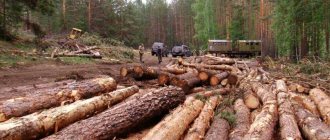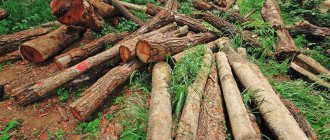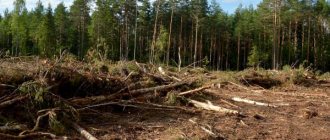Article 260 of the Criminal Code of the Russian Federation Illegal logging of forest plantations among environmental crimes is the most common in practice. The composition provides for felling or damage to the point of stopping the growth of forest plantations or trees, shrubs, and vines not classified as forest plantations, committed illegally, that is, in the absence of a special permit (for example, a felling ticket, etc.). The Code of Administrative Offenses in Article 8.28 provides for liability for a similar act, in contrast to Art. 260 of the Criminal Code of the Russian Federation is that criminal liability occurs if there is a significant amount.
Thus, for liability to arise under Art. 260 of the Criminal Code of the Russian Federation requires such signs as:
- the presence of the act itself (cutting or damage until growth stops);
- illegality of the said act (lack of permission, felling certificate);
- significant size.
The presence of these three signs form a simple composition of Art. 260 of the Criminal Code of the Russian Federation, which provides for punishment of up to two years in prison.
Part 2 Art. 260 of the Criminal Code of the Russian Federation provides for a more severe sanction - up to four years in prison, and is characterized by additional qualifying characteristics - a group of persons using their official position on a large scale. Part 3 of this article is formed by such qualifying features as especially large size, a group of persons by prior conspiracy, an organized group, and belongs to the category of serious crimes since the maximum sanction for such a crime is up to 7 years of imprisonment.
The question arises of what is considered significant, large and especially large in size under this article.
According to the notes to Art. 260 of the Criminal Code of the Russian Federation, a significant amount in this article recognizes damage caused to forest plantations or trees, shrubs and vines not classified as forest plantations, calculated according to the rates and methods approved by the Government of the Russian Federation, exceeding five thousand rubles, large-scale - fifty thousand rubles, especially large-scale size - one hundred fifty thousand rubles. CRIMINAL LAWYER call now: ☎ 8 (495) 532-75-40
Protection under Art. 260 of the Criminal Code of the Russian Federation Illegal felling of forest plantations
The defense for illegal logging of forest plantations depends on the specific circumstances of the case. Based on all the nuances, a defensive position is built, the possibility of excluding qualifying criteria is checked, the possibility of reclassifying the act as an administrative offense or a more lenient offense. It is also necessary to make full use of mitigating circumstances, to petition for documents positively characterizing the defendant to be included in the case materials; such circumstances are taken into account when considering the case in court and affect the verdict.
Amount of damage
It is mentioned in the footnote to Article 260. It defines significant, large and especially large damage.
The first is considered to be harm exceeding 10 thousand rubles. The calculation is made according to tariffs approved by the Government. Major damage is considered to be damage/cutting down of plantings in an amount greater than 100 thousand rubles, especially large damage – 250 thousand rubles.
Determination of the amount of material damage is carried out taking into account the environmental value of the number of cut down or damaged vines, shrubs, trees, and their value. Environmental damage caused to other plants as well as animals is taken into account. In addition, the calculation takes into account actual expenses aimed at compensating for the damage incurred.
Lawyer under Art. 260 of the Criminal Code of the Russian Federation Illegal felling of forest plantations
A lawyer for illegal logging of forest plantations will analyze the situation from a legal point of view and determine the prospects for protection based on the specifically charged elements of Art. 260 of the Criminal Code of the Russian Federation. The services of a lawyer include consultation and formation of a defense position, full support during the investigation, participation in all investigative actions, in court and in the appellate instance. If you or your relative are accused of illegal logging, contact a criminal lawyer for help, call the phone number listed on the website.
Commentary on Article 260 of the Criminal Code of the Russian Federation
1. The public danger of illegal logging, as well as damage to the point of stopping the growth of forest plantations or trees (shrubs, vines) not classified as forest plantations, lies in the uncontrolled destruction of trees and shrubs, thereby undermining the environmental safety of society.
Part 1 comment. The article defines the main, part 2 - qualified and part 3 - especially qualified elements of crime that describe socially dangerous acts belonging to the category of crimes of minor (parts 1 - 2) and medium (part 3) gravity.
2. The main object of criminal encroachment is the environmental safety of society, ensured by the protection, rational use and reproduction of trees and shrubs in forests; ecological balance and viability of trees and shrubs.
3. The subject of encroachment is considered to be damp-growing trees and shrubs in their natural state (standing). The Plenum of the Armed Forces of the Russian Federation in paragraph 11 of Resolution No. 14 of 05.11.1998 emphasizes: “The subject of criminal encroachment are trees, shrubs and vines growing on forest lands, in forests not included in the forest fund, on lands of transport, populated areas (settlements ), on lands of the water fund and lands of other categories.” Trees and shrubs growing on agricultural lands (with the exception of forest protection plantations), on household plots, summer cottages and gardens, windfall trees, windbreak trees, etc., cannot be the subject of an environmental crime, unless otherwise provided by special legal acts. It should also be borne in mind that the subject of the encroachment is the delimiter of liability for illegal cutting (as well as damage) of trees, bushes, vines in the criminal law (Article 260 of the Criminal Code) and administrative law (Article 8.28 of the Administrative Code) spheres.
4. Forest is a natural object protected by law, which is a collection of trees, shrubs and herbaceous vegetation growing on forest lands and lands of other categories, as well as the animals, microorganisms and other components of the natural environment inhabiting it, biologically interconnected and influencing each other in its development.
5. Forests located on forest fund lands are divided according to their intended purpose into: a) protective; b) operational; c) reserve. Forest fund lands consist of forest areas and forest parks. Forests located on lands of other categories can be classified as protective forests. Forest districts and forest parks are also located on the lands of: a) defense and security on which forests are located; b) settlements where urban forests are located; c) specially protected natural areas where forests are located (see Articles 10, 23 LC).
5.1. Protective forests include forests that are subject to development in order to preserve the environment-forming, water-protective, protective, sanitary-hygienic, health-improving and other useful functions of forests with the simultaneous use of forests, provided that this use is compatible with the intended purpose of protective forests and the useful functions they perform.
The following categories of protective forests can be distinguished: a) located in specially protected natural areas; b) located in water protection zones; c) performing the functions of protecting natural and other objects (forests located in the first and second zones of sanitary protection zones for sources of drinking and domestic water supply; protective strips of forests located along public railways, public federal highways, public highways owned by constituent entities of the Russian Federation; green areas, forest parks; urban forests; forests located in the first, second and third zones of sanitary (mountain sanitary) protection districts of medical and recreational areas and resorts); d) valuable forests (state protective forest belts; anti-erosion forests; forests located in desert, semi-desert, forest-steppe, forest-tundra zones, steppes, mountains; forests of scientific or historical significance; walnut production zones; forest fruit plantations; ribbon pine forests) (see Art. 12, 102 LC).
5.2. Exploitative forests include forests that are subject to development for the purpose of sustainable, most efficient production of high-quality wood and other forest resources, their processed products, ensuring the preservation of the useful functions of forests (see Articles 12, 108 LC).
5.3. In protective and exploitation forests, specially protective forest areas can be identified, which include: a) bank protection, soil protection areas of forests located along water bodies and ravine slopes; b) forest edges bordering treeless spaces; c) permanent forest seed plots; d) protected forest areas; e) forest areas with the presence of relict and endemic plants; f) habitats of rare and endangered wild animals; g) other specially protected forest areas (see Art. 102 LK).
5.4. Reserve forests include forests in which no timber harvesting is planned for 20 years. The use of such forests is permitted after they are classified as operational or protective forests (see Article 109 of the Leningrad Code).
6. The objective side of the crime is expressed in the form of an action - illegal cutting or illegal damage to the point of stopping the growth of forest plantations or trees, shrubs, and vines not classified as forest plantations.
6.1. Felling is the separation of a damp-growing trunk from the ground, for example, by felling, sawing, uprooting and similar methods. As a rule, illegal logging is carried out during logging, laying routes for pipelines, power lines, geological exploration, construction and other work.
6.2. Felling is considered illegal in cases where it is carried out: a) without a logging ticket or warrant; b) on a logging ticket (warrant) issued in violation of the current logging rules; c) to a greater extent than provided for in the relevant document; d) at an unspecified (in the document) felling period; e) in relation to trees that are not the same species or are not subject to felling, as are indicated in the logging ticket (order), or are prohibited from cutting by the Rules for the release of standing timber in the forests of the Russian Federation, approved. Decree of the Government of the Russian Federation dated June 1, 1998 N 551 (as amended on November 18, 2006) <1>; f) in a manner not specified in the relevant document; g) in areas not intended for logging; h) after a decision has been made to suspend, limit or terminate the activities of a forest user or the right to use a forest fund site (see paragraph 2, paragraph 11 of the Resolution of the Plenum of the Armed Forces of the Russian Federation dated November 5, 1998 N 14). ——————————— <1> NW RF. 1998. N 23. Art. 2553; 2002. N 39. Art. 3801; 2006. N 13. Art. 1401, N 48. Art. 5029.
6.3. Damage (to the point of cessation of growth) is the loss of a tree, shrub or vine of its natural functions (regeneration, reproduction, etc.) and their subsequent drying out. Damage can occur as a result of destruction of the crown or root system of the plant, splitting, fragmentation of the tree, etc.
7. The disposition of the article is of a reference-blanket nature, i.e. to determine the criminality of an act and its proper qualification, refers the law enforcement officer to other laws and by-laws that regulate a person’s attitude to the use of trees, shrubs and vines, both included and not included in the forest fund, for example, such as the Forest Code; Sanitary rules in forests of the Russian Federation, approved. By Order of the Ministry of Natural Resources of Russia dated December 27, 2005 N 350 (as amended on April 5, 2006) <1>; Regulations on the use, protection, protection of the forest fund and reproduction of forests previously in the possession of agricultural organizations, approved. Decree of the Government of the Russian Federation dated December 19, 1997 N 1601 (as amended on April 21, 2003) <2>; Regulations on the implementation by the Federal Service for Supervision of Natural Resources and its territorial bodies of state control over the condition, use, protection, protection of the forest fund and forest reproduction, approved. Decree of the Government of the Russian Federation dated October 6, 2005 N 600 (as amended on November 15, 2006) <3>; Basic provisions for the sale of standing timber at auctions in the Russian Federation, approved by the Scientific and Technical Council of the Federal Forestry Service of Russia, protocol dated July 27, 1993 N 2. ——————————— <1> BNA . 2006. N 13, N 19.
<2> Northwestern Russian Federation. 1998. N 1. Art. 121; 2003. N 17. Art. 1613.
<3> Northwestern Russian Federation. 2005. N 42. Art. 4279; 2006. N 47. Art. 4919.
8. A mandatory feature when qualifying an act as a crime may be one of the ways of committing it: a) damage to the point of stopping the growth of forest plantations or trees, shrubs or vines not classified as forest plantations; b) cutting them down. These methods in any case presuppose the active criminal behavior of the guilty person.
9. According to the legislative structure, the corpus delicti provided for in Part 1 of the comment. article is material. The crime is completed (by elements) at the moment of causing significant damage by illegal felling or illegal damage to the point of stopping the growth of forest plantations or trees (shrubs, lianas) not classified as forest plantations, regardless of whether the felled wood was used by the offender or not.
10. The crime revealed in part 2 comments. article, terminated (by composition) in case of illegal logging or illegal damage to the point of stopping the growth of forest plantations or trees (shrubs, vines) not classified as forest plantations in forests of all groups or plantations not included in the forest fund, carried out (or carried out) by a group of persons or by a person using his official position, as well as causing (resulting in) damage on a large scale.
10.1. About the group of persons, see paragraph 2 of the comment. to Art. 35.
10.2. Repeatedness (in the broad sense of the word) as a form of plurality of crimes is excluded from Part 2 of the commentary. Articles of the Federal Law dated December 8, 2003 N 162-FZ.
10.3. The use by a person of his official position presupposes the exercise by this person of the powers granted in his service to facilitate the commission of a crime, as well as the use of his professional status.
10.4. Abuse of official powers or the powers of a person performing managerial functions in a commercial or other organization during illegal felling (damage) of forest plantations or trees (shrubs, vines) not classified as forest plantations does not require additional qualifications under Art. 285 or 201. Here it is enough to use paragraph “c” of Part 2 of Art. 260 (see paragraph 10 of the Resolution of the Plenum of the Armed Forces of the Russian Federation dated November 5, 1998 N 14). It should be taken into account that an official (forester, forest foreman, forester, etc.) is the subject of a criminal attack provided for in Part 2 of the comment. article, only if he commits a corresponding socially dangerous act on the territory (site, bypass, block, etc.), within which his official powers can be exercised.
11. The crime described in part 3 of the comment. article, completed (by composition) at the time of the commission of the act provided for in Part 2 of the comment. article, not on a large scale by a group of persons by prior conspiracy or by an organized group, or the commission of an act provided for in Part 1 or 2 of the comment. article, on an especially large scale, as well as by a group of persons by prior conspiracy or by an organized group on a significant (Part 1) or large (Part 2) scale.
11.1. For a group of persons by prior conspiracy, see clauses 3 - 3.2 of the comment. to Art. 35.
11.2. About the organized group, see paragraph 7 - 7.1 comment. to Art. 35.
12. Note on comments. The article defines significant, large and especially large amounts of damage caused by illegal logging (damage) to forest plantations or trees (shrubs, vines) not classified as forest plantations.
12.1. A significant amount of damage caused to forest plantations or trees, shrubs, and vines not classified as forest plantations is recognized, calculated according to the taxes approved by the Government of the Russian Federation (see rates for calculating the amount of penalties for damage caused to the forest fund and forests not included in the forest fund by violation of the forest legislation of the Russian Federation, approved by Decree of the Government of the Russian Federation of May 21, 2001 N 388 <1>), exceeding 10 thousand rubles. On a large scale - 100 thousand rubles. In a particularly large amount - 250 thousand rubles. ——————————— <1> NW RF. 2001. N 22. Art. 2236.
12.2. When determining the amount of damage, one should proceed from the cost, ecological value of the number of cut or damaged forest plantations or trees, shrubs, vines not classified as forest plantations, the amount of damage caused by illegal logging to other flora and fauna, as well as from the actual costs of compensation for the damage caused. .
13. The subjective side of the crime is characterized by guilt in the form of intent or negligence. In the case of an intentional form of guilt, the person realizes that he is carrying out (gives an order for this purpose) illegal cutting (damage) of forest plantations or trees, shrubs, vines not classified as forest plantations, foresees the possibility or inevitability of the occurrence of significant (large or especially large) size (including destroying or damaging specially protected tree species) and desires or consciously allows this harm to occur (in some cases, it is indifferent to its occurrence). In case of a careless form of guilt, the person foresees the illegality of cutting (damaging) forest plantations or trees, shrubs, vines not classified as forest plantations, the possibility of material socially dangerous consequences occurring as a result, but without sufficient grounds for this, arrogantly hopes to prevent them or does not foresee the possibility of occurrence these consequences, although with the necessary care and forethought it should and can foresee these consequences. Careless damage to trees and shrubs can be observed, for example, during logging - felling or removal of timber.
13.1. The mental attitude of the perpetrator to the illegal cutting (damage) of forest plantations or trees, shrubs, and vines not classified as forest plantations can be characterized by two forms of guilt (complex guilt), for example, when the guilty person knowingly carries out illegal logging operations, foresees damage in a significant amount, but damage on a large or especially large scale occurs against his will. In general, such a crime is considered intentional (Article 27). If the culprit knowingly illegally cuts down or damages forest plantations or trees, shrubs, and vines that are not classified as forest plantations, but is careless in causing significant damage, then one should talk about mixing guilt in an administrative offense (Article 8.28 of the Code of Administrative Offenses) and crime (Article 260 of the Criminal Code) (i.e. mixed guilt).
13.2. The intent of the perpetrator must be aimed at cutting down (damaging) standing trees and shrubs. If a person takes possession of trees cut down and prepared for storage, sale or export by other persons, his act should be qualified as theft of someone else’s property (see paragraph 4 of paragraph 11 of the Resolution of the Plenum of the Armed Forces of the Russian Federation of November 5, 1998 N 14). In the case of felling and collection of windfall and windfall forest, stumps, dead wood, which caused significant harm to the forestry industry, forestry or other similar organizations, the issue of the criminal liability of the perpetrator may be considered in accordance with Art. 330 (arbitrariness).
14. The subject of a criminal offense is considered to be a sane individual who has reached the age of 16 at the time of committing the crime, including an official, by order or authorization of which illegal felling (damage) was carried out to the extent that the growth of forest plantations or trees not classified as forest plantations ceased. , bushes, vines. Improper performance by officials of official duties for forestry management, state control over the condition, use, reproduction, protection and protection of forests of the Russian Federation, which caused major damage (damage the amount of which exceeds 100 thousand rubles), should entail a management in accordance with Art. 293.
Subjective aspect
It is characterized by intentional or reckless guilt.
In the first case, the citizen understands that he is illegally cutting down/damaging vegetation classified and not classified as part of the Russian forest fund, or gives an order for this. At the same time, he assumes the inevitability/possibility of damage to the ecological system and desires/consciously allows its occurrence.
In the case of an assault committed in a careless form of guilt, the subject also understands the illegality of his actions, foresees negative consequences, but arrogantly, without sufficient grounds for this, hopes to prevent them, or does not foresee damage, although with due care and attention he should have foreseen it. Careless damage to plantings occurs, for example, when harvesting trees during felling or removal.
A person’s mental attitude towards a crime can be characterized by guilt in 2 forms. For example, an entity deliberately carries out deforestation and expects significant damage, but regardless of its will, damage occurs on a particularly large scale.





